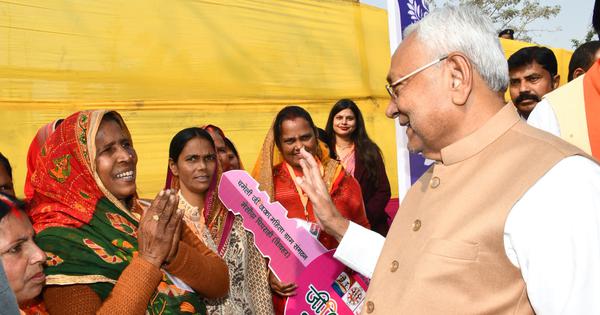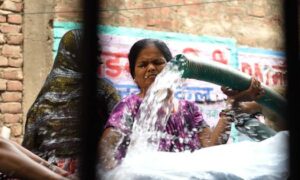
The number of registered women voters in Bihar has fallen below their share of population after the special intensive revision of voter lists by the Election Commission, shows Scroll’s analysis of final voter lists published on September 30.
The fall is acute in constituencies won by Chief Minister Nitish Kumar-led Janata Dal (United) in the 2020 Assembly elections.
Nitish Kumar’s support among women voters is believed to be one of the reasons for the National Democratic Alliance’s electoral success in the 2020 elections.
The alliance, which is led by the Bharatiya Janata Party and the JD(U), won 125 of the 243 seats.
The exclusion of women is evident in the gender ratio of the electorate, which measures the number of women for every thousand men among registered voters.
In January 2025, the gender ratio of the Bihar’s electorate was 914 – that is, for every thousand registered male voters, Bihar had 914 registered female voters.
After the SIR, this figure has fallen to 894.
This is lower than the state’s gender ratio. According to the 2011 census, Bihar has 918 women for every thousand men.
Disproportionate exclusion of women
Women voters made up 47.8% of Bihar’s electorate on January 1, 2025. In the final roll after the special intensive revision, this decreased to 47.2%.
Nearly 59% of the voters deleted during the SIR are women. This becomes clear after comparing Bihar’s electoral roll released in January and the final roll released on September 30, 2025.
In all, the gender ratio among registered voters has fallen in 230 of 243 Assembly constituencies in the state. This map tracks the drop in points in every constituency.
The highest drop is recorded in Kuchaikote Assembly constituency in Gopalganj district in western Bihar, where the SIR has reduced the gender ratio from 956 to 861. The JD(U) won this seat in the 2020 Assembly polls. Of the 10 seats which saw the highest fall in the gender ratio, three had been won by the JD(U) in the last elections.
Among districts, Gopalganj district has the highest gender ratio drop in Bihar. Two districts from the state’s Muslim-heavy Seemanchal region, Kishanganj and Purnia, are also in the top ten.
Of the 13 constituencies in the state where the gender ratio has increased, the highest has been in Barhara seat in Bhojpur district, where it rose from 856 to 890.
Bhojpur is the only district in Bihar to register a better gender ratio after the SIR, inching from 877 to 880.
Low in additions, high in deletions
On August 1, five weeks after the SIR began, the EC published a draft roll with names of 7.24 crore voters – 65 lakh short of the 7.89 voters who were in the roll before the exercise began. It said that there were four reasons for excluding these voters: they had either died, shifted permanently, enrolled in multiple booths or were absent from their addresses.
As Scroll had reported, women made up 55% of excluded voters.
The poll body then started a process of adding and deleting voters from this draft roll.
Between August 1 and September 30, it added 21.5 lakh voters and deleted 3.6 lakh voters, shows the final roll.
Even in this process, women were at a disadvantage. For one, they were underrepresented among those added to the draft roll. Only 10.3 lakh of the 21.5 lakh new voters are women, that is about 47.8%.
In seven districts – Buxar, Sheikhpura, Katihar, Gopalganj, Saran, Banka and Bhojpur – women form 45% or less of the voters added to the draft roll.
On the other hand, they are overrepresented in those deleted from the draft roll. Nearly 2 lakh of the 3.6 lakh deleted voters from the draft roll are women – a share of 53.9%.
In Supaul district, nearly 75% of deleted voters from the draft roll are women.
The JD(U) problem
Since 2010, voter turnout among women in Bihar has been higher than men in the Assembly elections.
According to a pre-poll survey in 2020, women were more likely to vote for the National Democratic Alliance than the opposition Mahagathbandhan alliance, which chiefly includes the Rashtriya Janata Dal and the Indian National Congress.
A post-poll survey showed that a significant section of women from the upper castes and the non-Yadav other backward classes powered the National Democratic Alliance’s victory. These caste groups make up more than 60% of Bihar’s population, according to the 2023 caste survey in the state.
Not surprisingly, ahead of the upcoming elections, the National Democratic Alliance government has pulled out all stops to woo women, with Rs 10,000 being transferred to each woman under the Mukhyamantri Mahila Rojgar Yojana.
But, given the alliance’s popularity among women voters, their disproportionate exclusion in the SIR could impact the National Democratic Alliance more than others.
In fact, Election Commission data shows that the JD(U) is more exposed to this risk than others. Among major parties, on average, the gender ratio has fallen the most in seats that the JD(U) won in the 2020 Assembly elections.
Its alliance partner, the BJP, might be least affected by the exclusion of women voters, as this graph shows.
Even if we calculate the average drop in gender ratio for contested seats, the JD(U) comes out on top among major parties.
The final SIR voter list is still open to revisions. The roll for the upcoming Assembly polls will be published on the last day of filing nominations – October 17 for the first phase and October 20 for the second phase of polls.
📰 Crime Today News is proudly sponsored by DRYFRUIT & CO – A Brand by eFabby Global LLC
Design & Developed by Yes Mom Hosting






